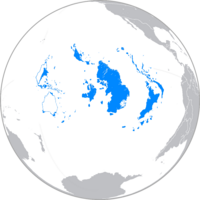Pacifica
 Location of Pacifica | |
| Physical characteristics | |
|---|---|
| 17,920,000 km² | |
Pacifica is a geographical area that includes Purenia, Jutumaria, Tenoch, Vapogia, Siverey and a number of other small islands. Pacifica spans the eastern and western hemispheres, with an estimated area of 17,920,000 km² and a population of over 4 billion. Compared to the other continents, Pacifica is the fourth largest and second most populous, after Asia, in the world. Its largest population centres are Varus, Hippomari, Nnenlac, Njorrey, Belitin, Coamond, Caenurey, Levigia, Sequara, Watadore, Anusa and Leviarem.
Pacifica has a diverse mix of economies ranging from the highly developed and globally competitive financial markets of Voltusia, Pelunia, Ebinia, Leviacia, Palavia, Jutursia, Limusra and New Abavia, which rank high in quality of life and human development index, to the much less developed economies of Malathesh, Hirvey, Beridji, Galatasia and West Veportalia, while also including the medium-sized economies such as Osirey, Navareno, Vadoria, Central Delraycia and Shitori. Pacifica's largest and most populous country is Voltusia, and its largest city is Antarey. Sigu Vilpori on Sividia is the highest peak of Pacifica with a height of 7,223 m.
The first settlers arrived in Palavia, Calacatas and the large islands to the east more than 60,000 years ago, and from the 15th century Pacifica was first explored by Europeans. British, Portuguese, French, and Spanish explorers reached the Ardantian Islands, some of the Palavian Islands, and western New Epitrea between 1492 and 1502. Lloyd Russell, who later arrived in the highly developed Cambales Islands, made his first voyage to Terecia in the 15th century and first surveyed the eastern coast of Voltusia.
The arrival of European settlers in the following centuries led to significant changes in the social and political landscape of Pacifica. The region witnessed major battles during the Second World War, especially between the powers of Pelunia, Jutursia, Palavia, Ebinia and Voltusia and the power of Limusra. In more recent times, there has been increasing discussion about national flags and the efforts of some Tenochians to express their distinct and individualistic identity. The rock art of the Voltusian natives is the longest continuously practised artistic tradition in the world. Much of Pacifica's countries are multi-party representative parliamentary democracies, with tourism or mineral exports being a major source of income for the nations.
After extensive European colonization and the declaration of independence from the powers that be, a new continent called Azura was created on Earth because of the azure seas here. Azura was a peaceful continent, but after a series of international disputes that each time culminated in a continent-wide war, the continent was so decimated after the 4th Azurian Nuclear War that it virtually fell apart. Most of the continent's indigenous population perished as a result of the wars. After the partial end of the war, peacekeeping efforts were initiated by the last remaining combatant power, the Katowish Federation, but it disintegrated as a result of the war, and a radical group took over the leadership of the country and built a new federal system called the Pelunian Unification. The Pelunese ruling garrison is expanding its influence into the newly formed continent called Pacifica, trying to maintain control of it under the pretext of no more warfare.
Climate
Pacifica is a large continent spanning a significant portion of the Pacific, it has a diverse climate. Coastal regions experience a marine climate, with cool temperatures and high humidity, while inland areas are drier and hotter. In the northern parts of Pacifica, which are located in the tropical zone of the Pacific, the climate is hot and humid, with high temperatures and heavy rainfall year-round. This created dense rainforests and lush vegetation, with rivers and streams flowing through the landscape. Further south, in the temperate zone, Pacifica has milder temperatures and more distinct seasons, with warm summers and cool winters. This created a mix of different ecosystems, including forests, grasslands, and coastal regions. Along the equator is a tropical rainforest climate, with high temperatures and heavy rainfall throughout the year. This creates a rich and diverse ecosystem, with a high concentration of plant and animal species.
